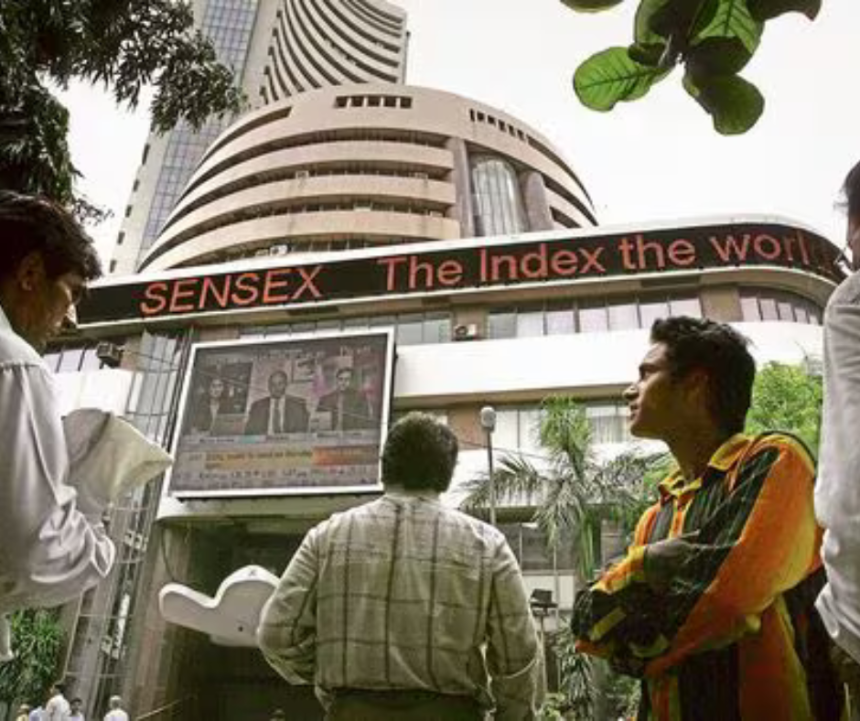Sensex, Nifty 50 Extend Losses: A Deep Dive Into Today’s Indian Stock Market Trends.
Indian stock market witnessed heightened volatility on Friday, May 9, with major benchmark indices, Sensex, and Nifty 50, continuing to make their way downwards into the second consecutive session. Geopolitical tensions, profit booking after a good rally, and mixed global cues drove the downdraft.
Investors were cautious on the rising tension between Pakistan and India, therefore providing the market with an extra factor of uncertainty. Also, concerns for rising US bond yields and volatile crude oil prices put further pressure on sentiments.
Following is a detailed insight into the 10 important highlights of today’s session of trading in the Indian stock market, along with expert views regarding what the future holds.
1. Downfall of Sensex and Nifty 50 by Sharp Values
The BSE Sensex closed at 79,454.47, falling by 880 points (1.10%), and the NSE Nifty 50 settled at 24,008, falling by 266 points (1.10%). The sell-off was across-the-board, led by banking, IT, and energy Indian Stock Market.

Expert Take:
Market experts give this correction due to profit booking following a strong rally. The Sensex had just reached an all-time high, and hence a pullback was anticipated. But geopolitical threats intensified the pressure of selling.
2. Midcap and Smallcap Indices Demonstrate Relative Strength
Whereas large-cap shares witnessed massive selling, BSE Midcap and Smallcap indices presented resilience. The Midcap index lost a mere 0.10% and the Smallcap index lost 0.30%, which suggests that retail investors were still present in the chosen scrips.
Important Observation:
This pattern indicates that even in the overall market weakness, investors are looking for opportunity in fundamentally sound mid and small-cap stocks. Sectors such as defence, railway, and PSUs witnessed selective buying.
3. Market Capitalisation Plunges by ₹2 Lakh Crore
The overall market capitalisation (m-cap) of listed companies on BSE declined from ₹418.50 lakh crore to ₹416.8 lakh crore, erasing almost ₹2 lakh crore of investors’ wealth in a day’s trading.
Effect on Investors:
This harsh depreciation in market value reflects the dangers of geopolitical unpredictability. Leverage investors received margin calls, precipitating the sell-off.
4. Weekly Performance: Sensex & Nifty Snap 3 Week Winning Streak
The Sensex declined 1.30% for the week, while the Nifty 50 declined 1.40%, thus ending the three-week streak of winning days. The correction was mainly due to:
- Profit booking post heavy rally;
- Rise in US Treasury yields causing FII outflows, and
- Geopolitical tensions between India and Pakistan
What’s Next?
If Nifty 50 stays above 23,800, then there can be a recovery. But a dip below this can lead to further downsides.
5. Geopolitical Tensions Keep Investors on Edge
The increasing tensions between India and Pakistan gave rise to a risk-off sentiment in the market. Further escalation can lead to:
- Increased volatility in equities
- Stronger demand for safe-haven assets like gold and bonds
- Pressure on the rupee if foreign investors pull out
Market Reaction:
Some buying was witnessed by defense stocks, while sectors such as aviation and tourism experienced selling pressure on account of possible disruptions.
6. Banking & Financial Stocks Drag the Market

The Bank Nifty fell 1.5%, with major lenders like HDFC Bank, ICICI Bank, and SBI leading the decline. Rising bond yields and concerns over loan growth slowdown contributed to the weakness.
Analyst View:
Banking stocks may remain under pressure if US Fed rate cut expectations diminish further. Investors should watch for RBI’s policy stance in the coming months.
7. IT & Pharma Sectors Under Pressure
IT shares, which had seen the recent rally, witnessed profit unwinding. Infosys, TCS, and Wipro dropped 1-2% with concerns about overseas demand. Shares of pharma companies were also weak due to mixed earnings as well as margin pressures in the US market.
Outlook:
The IT segment can recover in case US Fed gives indications about rate cuts, while pharma shares might become stable with the focus on specialty drugs.
8. FIIs Turn Net Sellers, DIIs Provide Support
Foreign Institutional Investors offloaded shares with the approximate value of Rs. 1,200 crores, whereas Domestic Institutional Investors bought shares of around Rs. 900 crores in value.
Why It Matters:
FII selling may continue to extend the correction, but firm DII buying can act as a cushion.
9. Gold & Bonds Gain as Safe-Haven Demand Increases

As equity markets came under stress, investors turned to gold and government bonds. Domestic gold prices appreciated, whereas the 10-year bond yield eased marginally.
Investor Takeaway:
Diversify into debt securities or gold to hedge against market volatility.
10. Market Outlook: A Correction or More Downside?
Bull Case:
If Nifty holds 23,800, a rally towards 24,300 can happen.
Strong earnings and an easing of geopolitical tension should help market sentiment revive.
Bear Case:
A breach below 23,800 may provide deeper correction towards 23,500.
With crude prices rising and FII outflows, further fall may continue.
FAQs: Sensex & Nifty 50 Fall for Second Session – 10 Key Market Highlights
1. Why are Sensex and Nifty falling for two consecutive sessions?
The markets are declining due to [mention key reasons – e.g., weak global cues, profit booking, sectoral sell-off, geopolitical concerns, etc.].
2. How much did Sensex and Nifty drop today?
- Sensex fell by [X] points (X%) to close at [Y].
- Nifty 50 declined by [A] points (A%) to settle at [B].
3. Which sectors dragged the market down the most?
Major laggards included [list sectors – e.g., banking, IT, auto], while [mention any resilient sectors] showed stability.
4. Were there any top gainers in today’s session?
Yes, [stock names] rose due to [reasons – e.g., strong earnings, positive news].
5. What is the impact of global markets on Indian stocks?
[Explain influence – e.g., US Fed rate concerns, Asian market slump, crude oil volatility].
Expert Advice:
Yet, do remember to stay alert and do not panic sell; rather, one should seek opportunities to buy quality stocks at cheaper levels.
Last Word
The Indian market is undergoing a healthy correction after a sharp rally; however, geopolitical tensions have added to the volatility. While large caps bore the brunt of selling, mid and small caps remained strong.
Key Takeaways for Investors:
- Monitor geopolitical developments and global market trends.
- Focus on sector rotation—defense, PSUs, and FMCG may outperform.
- Maintain a balanced portfolio with equities, gold, and bonds to hedge risks.
The long-term scenario of the Indian stock market is still positive, but there could be short-term volatility. Stay updated, stay patient, and invest strategically.











